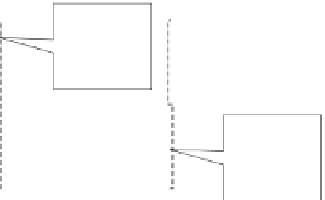Graphics Reference
In-Depth Information
variable
threshold
(
k
+1
)-th order Exp-
Golomb
Truncated
Unary
B
0
0
... B
0
(
B
1
+
1)
...
Absolute Level
(
B
0
+
1)
...
B
1
z
Using SIG, ALG1,
and ALG2 flags
variable
threshold
k
-th order Truncated
Rice
B
1
Fig. 8.22
Illustration of the adaptive binarization scheme for absolute levels in HEVC consisting
of a concatenation of the three elementary binarizations TrU, TRk, and EGk, the latter two with
varying order k and k
C
1, respectively (0
k
4). The two variable thresholds B
0
and B
1
specify the (variable) transition points between them
of the last non-zero coefficient in the subblock in reverse scanning order, as will be
discussed in more detail in Sect.
8.6.5.2
. Finally, in the last and fifth scan pass, the
remaining information of absolute levels in the subblock (if present) is transmitted
by using the syntax element
coeff_abs_level_remaining
(ALRem), as will
be further detailed in Sect.
8.6.5.1
below.
8.6.5.1
Coding of Absolute Level
Coding of absolute levels requires the choice of suitable binarization schemes
and, for selected bin indices, the choice of suitable context models. According
to the design considerations, as discussed in Sect.
8.3
, both aspects of coding
efficiency and throughput have been properly addressed by the revised CABAC
design of HEVC. This is especially true for the coding of absolute levels which
typically contribute the dominant portion to the total number of generated bins.
In the following, we will first elaborate on how the specific binarization scheme
for absolute levels in HEVC has been designed. Then, in the second part of this
subsection, we will present the context selection rules applied to the (few remaining)
regular coded bins of absolute levels, unless not already done so in Sects.
8.6.4.1
and
8.6.4.3
.
Conceptually, the binarization of an absolute level, denoted as
z
in the following,
relies on a concatenated application of three binarization processes [
21
,
54
,
59
]:
truncated unary (TrU), k-th order truncated Rice (TRk), and .k
C
1/-th order
Exp-Golomb (EGk). Figure
8.22
illustrates this binarization scheme for arbitrary
z
along the (discrete) number line. There are two thresholding parameters B
0
;B
1
with B
0
<B
1
which separate the three regions from one another for application
of each of the three binarization processes and which also determine the truncation
parameters cMax(TrU)
D
B
0
C
1 and cMax(TRk)
D
B
1
B
0
. The selection of the
two parameters B
0
;B
1
together with the choice of the parameter k is performed in
a backward-adaptive manner for each subblock in such a way that the resulting bin
strings are already close to a minimum-redundancy prefix code for the collection of






